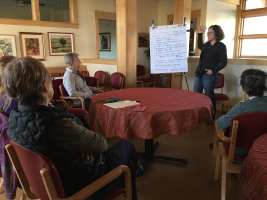
RN Lindy Cook gives a community orientation about the corona virus at an early meeting when the pandemic was still in its infancy.
A version of this story is now published in the fall 2020 edition of Communities No. 188. You download the publication here, courtesy of myself.
*************************************
One thing I’ve learned over the years, there’s nothing like a good old fashioned emergency to bring a community of any size together, from meeting your neighbor for the first time as a result of a power outage during a huge snowstorm to quickly spreading diseases like the coronavirus.
Cohousing communities and their residents are well equipped to deal with crisis situations, such as implementing current COVID-19 / Coronavirus prevention measures without resorting to martial law.
Internationally, nationally, and locally, hyper-vigilance will create political heroes, increase ratings on cable TV talking heads shows, sell more toilet paper – but in the long run, save lives, and bridge social and cultural divides.
We cohousers are predisposed to be hedges against isolation through collaboration, sharing of time and resources, and keeping track of one another. We’re big on meetings and getting together to make decisions about stuff.
Cohousing Association of the U.S. held a national online webchat about what other communities are doing around the country to respond to COVID-19. There is an online series that continues. Recordings will be available for those unable to participate live.
At my place, we have several neighbors self-isolating because of actual illness, having returned from travel or just being cautious. That hasn’t deterred the community from getting together.

A virtual community meeting was held on the zoom.us platform for residents to talk about how to limit outside use of the Common House. All households were represented.
My community has convened a series of Zoom.us online conversations and reached consensus together on a set of common sense guidelines around how to use the community common house during lockdown.
Over the past few weeks, our resident opinions were all over the spectrum from “This is a hoax” to “I’m not worried” to “Put on the haz-mat suits.”
Myself? I’m more of a “Business as usual” guy, as far as my being “freaked out” quotient goes. I’ve been catching up on pandemic-related movies and TV shows. Last night “Outbreak” with Dustin Hoffman and Rene Russo was on Prime Video.
On Netflix, I’m watching a TV series called “Containment” about what happens among frustrated people during a viral outbreak in a quarantine area where there are too many “rats in a cage.” Next are the classic “Andromeda Strain” and “Contagion” with Gwyneth Paltrow. There’s a good one called “Flu” from Korea, but it’s subtitled – I’ll watch that when I can concentrate more.
But in the cohousing community, my behavior is to observe the the most important lowest common denominator, which is hyper-vigilance.
Silver Sage Village COVID-19 guidelines generally prohibit outsiders from entering the common house, and itinerant use by community members.
During normal times, the building is seldom frequented except for a few people using the laundry, residents checking the mail, getting items from the storage room, the new social distancing criterium isn’t much of an inconvenience. The mailman is asked to wipe the mail boxes.
Most Baby Boomers, including myself, were around during the 1950s and 1960s toward the end of the polio pandemic, and the swine flu that spread in 2009, which coincided with the financial system collapse.
My family provided support when the oral polio vaccines came out. In my grade school one kid recovered from polio and wore a leg brace ala Forrest Gump. He was bullied because he also wore a hearing aid – back then, they were very conspicuous, with earphones wired to a receiver the size of a Band-Aid box.

I remember my grandfather’s insulin syringe as looking similar to this Dr. Frankenstein item.
Jonas Salk developed the first vaccine that was administered by injection. Getting jabbed with what seemed to be a needle the size of a railroad spike was my first shot.I don’t remember being freaked out about it.
Living on top of others is not new to me. One time, my grandfather, who had diabetes stayed with us. My grandmother was unable to care for him at the time since she was running the family business, the Highway Cafe.
I had to give up my bedroom, but went in to see him every morning because I was curious about the insulin shots he administered to himself. He let me poke him with the big syringe. It was a glass barrel connected to a stainless steel contraption. I don’t know how sterile it could be, since it was only wiped off by a cloth and some alcohol.
Anyway, I didn’t have a fear of needles, still don’t.
Back in the 1960s, the vaccine development competition was fierce. In the case of polio, Albert Sabin won the oral vaccine contest. Polio vaccines were risky in that some people who were vaccinated contracted polio, but that risk was outweighed by the number of cases prevented.
I remember a big family social event was gathering at my grandparents house on 8th Street in the Southside of Cheyenne. We walked over to the fire station and stood in line with all the other neighbors to get a sugar cube with pink fluid dropped onto it. Seems like there were boosters necessary, but the most memorable was the first one.

During the 2009 swine flu pandemic, there wasn’t a run on food like now during the COVID-19 scare, but there were a billion cases and 500,000 deaths in 2009.
What about the swine flu pandemic from 2009? That was a pretty big deal. Obama had a lot on his plate back then keeping the auto industry and banks stable. He eventually declared swine flu a national emergency. I had to look it up to refresh my memory.
I don’t remember anything about self-isolating, wiping doorknobs with Clorox, social distancing or anything like what’s happening now – but 500,000 people died and a billion were sick around the world. Turned out, saving the world economy was more important than saving people.
There were warnings about the swine flu contagion, but no mass closures of schools or businesses, nor were employees self-isolating in mass numbers.
The coronavirus outbreak could be a lot like the swine flu and the crash of 2009. Getting ahead of the disease and propping up the economy is the best we can hope to minimize disruptions.
Cohousers have the wherewithal to fast track hyper-vigilant responses to the control the COVID-19 virus. The U.S. government getting out in front with an economic stimulus package that includes couple Andrew Yang-esque Uniform Basic Income payments of $1,000 to most people, will be a short-term shot in the arm.
I don’t know about you, but I have plenty of toilet paper in the bathroom cabinet – I’m a hoarder from way back. I’m eating up all my emergency food, though. Next crisis, I’ll stock up on my least favorite snacks.

I mentioned at the start about meeting my neighbor during a snowstorm. It was when I moved to Laramie for graduate school in 1976 or so and living at my parent’s townhouse.
There was a power outage and I saw my neighbor out on the walk. We were both checking out the situation – snow drifted to the side of the house and no power.
Turned out, he was a University of Wyoming alumnus and a former linebacker for the Pokes.
He and his family lived in Laramie during the off season when he wasn’t on the field playing for the St. Louis football Cardinals – it was none other than Conrad Dobler, pro-football’s “Dirtiest Player.”
Conrad turned out to be a pretty nice guy, and if you do anything over the next few weeks, get to know your neighbors, even if it’s from six feet away. Your lives may one day depend on your friendships.
